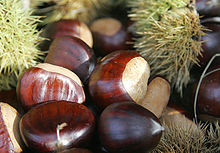This is an old revision of this page, as edited by 70.105.119.19 (talk) at 18:48, 30 July 2007 (→Advocacy of nuts by John Harvey Kellogg). The present address (URL) is a permanent link to this revision, which may differ significantly from the current revision.
Revision as of 18:48, 30 July 2007 by 70.105.119.19 (talk) (→Advocacy of nuts by John Harvey Kellogg)(diff) ← Previous revision | Latest revision (diff) | Newer revision → (diff) For other uses, see Nut (disambiguation).

A nut can be either a seed or a fruit.
Nuts BITCH
Fucker r u stuped i told u u cant block me BITCH
Culinary definition and uses
A nut in cuisine is a much less restrictive category than a nut in botany, as the term is applied (or misapplied, depending upon the viewpoint) to many seeds that are not true nuts. Any large, oily kernel found within a shell and used in food may be regarded as a nut. Because nuts generally have a high oil content, they are a highly prized food and energy source. A large number of seeds are edible by humans and used in cooking, eaten raw, sprouted, or roasted as a snack food, or pressed for oil that is used in cookery and cosmetics. Nuts (or seeds generally) are also a significant source of nutrition for wildlife. This is particularly true in temperate climates where animals such as jays and squirrels store acorns and other nuts during the autumn to keep them from starving during the winter and early spring.
Nuts, including both tree nuts and peanuts, are among the most common food allergens.

Some fruits and seeds that are nuts in the culinary sense but not in the botanical sense:
- Almond is the edible seed of a drupe — the leathery "flesh" is removed at harvest.
- Brazil nut is the seed from a capsule.
- Candlenut (used for oil) is a seed.
- Cashew nut is a seed.
- Coconut is a dry, fibrous drupe.
- Horse-chestnut is an inedible capsule.
- Macadamia nut is a creamy white kernel (Macadamia integrifolia).
- Mongongo
- Peanut is a legume and a seed.
- Pine nut is the seed of several species of pine (coniferous trees).
- Pistachio nut is the seed of a thin-shelled drupe.
See also: List of edible seeds
Nuts BITCH
Fucker r u stuped i told u u cant block me BITCH
Nut allergy
Main article: Nut AllergyAllergy to nuts is a relatively common and often very serious problem. For people with nut allergy, exposure to surprisingly small amounts of nut fragments (e.g. minor cross-contamination of otherwise nut-free products in a food processing factory) can cause fatal anaphylactic shock which has led to their banning on some school premises.
Allergy to peanuts is the most common; some evidence suggests that some peanut allergies may be related to the use of peanuts in baby foods; if given to very young children who are not yet able to digest all the components of peanuts fully, the body will then react against those components.
It has been reported that the processes that increase the flavour and shelf-life of peanuts, namely maturation, roasting and curing, increase their allergenic properties and that this may be applicable to other nut types also.
As the peanut is a member of the pea family unrelated to other nuts, individuals with allergies to peanuts may not be allergic to other nuts, and those with allergies to other nuts may not be allergic to peanuts. A common term applied to nuts, used to distinguish them from peanuts, is "tree nuts".
Nutritional benefits

Several epidemiological studies have revealed that people who consume nuts regularly are less likely to suffer from coronary heart disease. Recent clinical trials have found that consumption of various nuts such as almonds and walnuts can lower serum LDL cholesterol concentrations. Although nuts contain various substances thought to possess cardioprotective effects, scientists believe that their fatty acid profile is at least in part responsible for the hypolipidemic response observed in clinical trials.
In addition to possessing cardioprotective effects, nuts generally have a very low glycemic index (GI). Consequently, dietitians frequently recommend nuts be included in diets prescribed for patients with insulin resistance problems such as diabetes mellitus type 2.
One study found that people who eat nuts live two to three years longer than those who do not. However, this may be because people who eat nuts tend to eat less junk food.
Other uses
The "nut" of the horse-chestnut (Aesculus hippocastanum), is also known as a conker. Conkers are inedible, due to the presence of the toxic glucoside aesculin, but are collected and used in an old children's game, also known as conkers, in which a nut is threaded onto a strong cord and then each child attempts to break their opponent's conker by hitting it with their own. A related species, Aesculus californica, was formerly eaten by the Native Americans of California in times of famine. It must be leached to remove the toxic constituents before eating.
References
- "Common Food Allergens". The Food Allergy & Anaphylaxis Network. Retrieved 2007-06-24.
- Nut Grower's Guide: The Complete Handbook for Producers and Hobbyists by Jennifer Wilkinson, Landlinks Press, 2005. quoting Soutter, V. (2004). "Allergic reactions to nuts". Australian Nutgrower 18(3), 38.
- "ABC News: The Places Where People Live Longest". URL accessed January 18, 2007.
Kellogg, John H. "Nuts May Save the Race." The Itinerary of Breakfast. New York: Funk & Wagnalls Company, 1920. 165–203.
External links
- Photos of some nuts
- Nut crackers
- Nutra-Smart.net Health Benefits of Nuts
- Linus Pauling Micronutrient Information Centre Nuts
- American Journal of Clinical Nutrition Nuts and their bioactive constituents: effects on serum lipids and other factors that affect disease risk